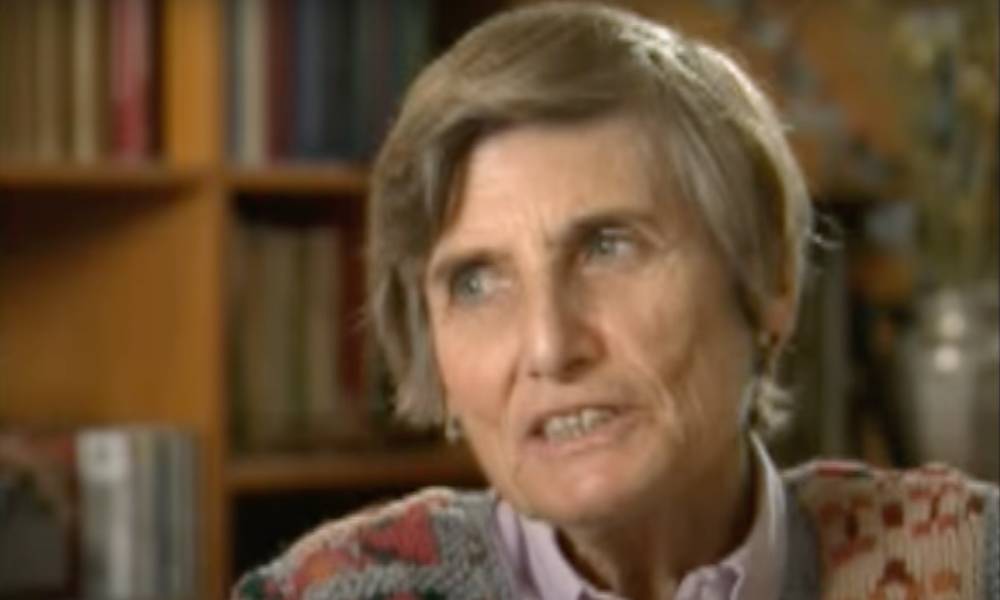Margot Heuman, a Holocaust survivor, opened up later in life about living in the concentration camps as a gay woman. (YouTube/Yad Vashem/USC Shoah Foundation Institute)
Margot Heuman, one of the few Holocaust survivors to testify about her life in the concentration camps as a gay woman, died at 94.
Margot Heuman died on 11 May at a hospital in Green Valley, Arizona. She is survived by her son, daughter, five grandchildren and one great-grandson.
When she was just 14 years old, Heuman and her family were deported to Theresienstadt – a town in what’s now the Czech Republic that was used as a ‘transit ghetto’ for Jews en route to death camps – in 1943.
Her family had been taken from their comfortable life in Germany, where Heuman was born on 17 February, 1928. According to The New York Times, Heuman was happy in Theresienstadt, and it was there that she fell in love with a Viennese girl named Dita Neumann.
Just a year later, in 1944, Heuman’s family was sent to Auschwitz after her father was caught stealing food. Neumann and her family were sent to the infamous death camp a month later.
Heuman’s loved ones – including her father, mother and youth sister – died in the camps. But Heuman and Neumann survived as they were transported to various camps, and Heuman said later in life that their bond kept them alive.
Margot Heuman said in an oral history recorded by the United States Holocaust Memorial Museum in 1992 that she “stuck together” with Neumann, adding “we shared everything”.
“All these years, after Auschwitz, I never ate anything without sharing it with her, no matter how hungry I was,” Heuman said.
She continued: “And she did the same, and I think if it hadn’t been for her, I wouldn’t be alive and I don’t think that she would be alive if it hadn’t been for our relationship either.
“Also because of my … caring for another human being, somehow we never lost our dignity and we remained people.”
Heuman and Neumann were last imprisoned at the Bergen-Belsen camp in Germany when it was liberated by British forces on 15 April, 1945. The forces found around 60,000 prisoners in the camp, most of them seriously ill, according to the United States Holocaust Memorial Museum.
Neumann was sent to England while Heuman was taken to Stockholm by the Swedish Red Cross.
Margot Heuman later moved to the US and she later married Charles Mendelson in 1952.
The pair had two children and divorced in 1976. Heuman said in 2019 that she felt like she “owed it to my parents to have children”, the New York Times reported.
Later in her life, Heuman decided to come out formally to her loved ones including her son, daughter and daughter-in-law. According to the New York Times, none of them were surprised as they didn’t think of her as being closeted.
She remained close friends with Neumann, who became a nurse and married a doctor in Canada. Heuman was by Neumann’s side when she died of cancer in 2011.
Dr Anna Hajkova, an associate professor at the University of Warwick, told the New York Times that Heuman was among the rare Holocaust survivors who “bore testimony” about her same-sex experiences in the concentration camps.
For a long time, Heuman presented her connection with Neumann as a strong friendship, but she later cast it as a romantic bond after she met with Dr Hajkova.
Dr Hajkova, who specialised in queer history and the Holocaust, said that “next to none” of the 52,000 interviews with Jewish survivors in the Shoah Foundation’s archives “speak about same-sex desire”.
Margot Heuman’s story will be included in Dr Hajkova’s upcoming book Quartet: Sexuality, Queer Desire and the Holocaust. Her story has also been performed as an one-act play titled The Amazing Life of Margot Heuman, which was first shown online at the 2021 Brighton Fringe Festival.
It’s scheduled to be performed this year at the University of Hamburg and the Jewish Museum in Vienna, the New York Times reported.
